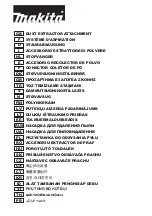
Page 3
connected and properly used.
Use of these devices
can reduce dust-related hazards.
Keep handles dry, clean and free from oil and
grease.
Slippery hands cannot safely control the
power tool.
Power tool use and care
Do not force the power tool. Use the correct power
tool for your application.
The correct power tool will
do the job better and safer at the rate for which it was
designed.
Do not use the power tool if the switch does not turn
it on and off.
Any power tool that cannot be controlled
with the switch is dangerous and must be repaired.
Disconnect the plug from the power source and/or the
battery pack from the power tool before making any
adjustments, changing accessories, or storing power
tools.
Such preventive safety measures reduce the risk
of starting the power tool accidentally.
Store idle power tools out of the reach of children and
do not allow persons unfamiliar with the power tool or
these instructions to operate the power tool.
Power
tools are dangerous in the hands of untrained users.
Maintain power tools. Check for misalignment or
binding of moving parts, breakage of parts and any
other condition that may affect the power tools oper-
ation. If damaged, have the power tool repaired
before use.
Many accidents are caused by poorly
maintained power tools.
Keep cutting tools sharp and clean.
Properly main-
tained cutting tools with sharp cutting edges are less
likely to bind and are easier to control.
Use the power tool, accessories and tool bits etc., in
accordance with these instructions and in the manner
intended for the particular type of power tool, taking
into account the working conditions and the work to
be performed.
Use of the power tool for operations dif-
ferent from those intended could result in a hazardous
situation.
Use clamps or other practical way to secure and sup-
port the workpiece to a stable platform.
Holding the
work by hand or against your body is unstable and may
lead to loss of control.
Battery tool use and care
Recharge only with the charger specified by the man-
ufacturer.
A charger that is suitable for one type of bat-
tery pack may create a risk of fire when used with
another battery pack.
Use battery tools only with specifically designated
battery packs.
Use of any other battery packs may cre-
ate a risk of injury and fire.
When battery pack is not in use, keep it away from
other metal objects like paper clips, coins, keys,
nails, screws, or other small metal objects that can
make a connection from one terminal to another.
Shorting the battery terminals together may cause
burns or a fire.
Under abusive conditions, liquid may be ejected
from the battery, avoid contact. If contact accidental-
ly occurs, flush with water. If liquid contacts eyes,
additionally seek medical help.
Liquid ejected from
the battery may cause irritation or burns.
Ensure the switch is in the off position before insert-
ing battery pack.
Inserting the battery pack into power
tools that have the switch on invites accidents.
Service
Have your power tool serviced by a qualified repair
person using only identical replacement parts.
This
will ensure that the safety of the power tool is main-
tained.
Develop a periodic maintenance schedule for your
tool. When cleaning a tool be careful not to disas-
semble any portion of the tool since internal wires
may be misplaced or pinched or safety guard return
springs may be improperly mounted.
Certain cleaning
agents such as gasoline, carbon tetrachloride, ammo-
nia, etc. may damage plastic parts.
SAVE THESE INSTRUCTIONS
DM 2610925743 02-05 2/7/05 9:33 AM Page 3




































